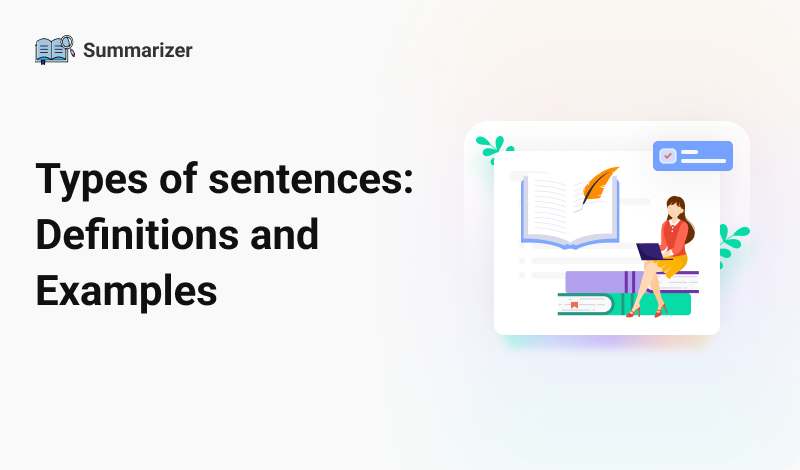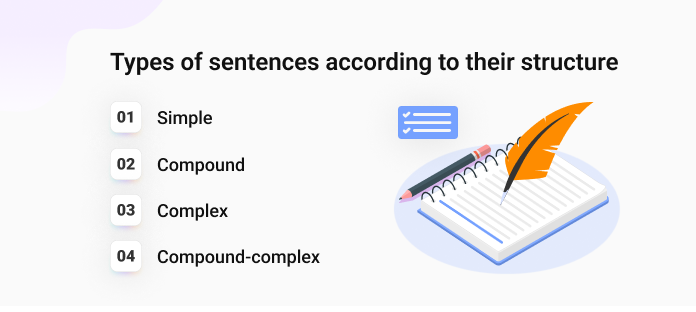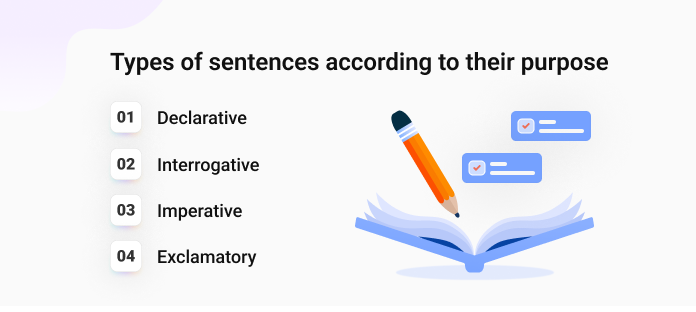
Sentences in English are classified according to two different factors i.e. their structure and function. One considers the structure of a sentence while the other categorizes the sentences according to their purpose in communication. Both of these factors divide sentences into 4 types.
In this article, we will learn the types of sentences from both aspects in detail.
Sentences are divided based on their structural elements. This division is based on the type and number of clauses.

The four types of sentences based on their structure are:
“The sentences which consist of a single independent clause are called simple sentences. It has a subject and a predicate and is complete without the need for any further explanation.”
Simple sentences are the most basic sentences in structure. They form the foundation for more complex sentence types.
Structure:
Here are the key elements of a simple sentence:
Subject: The subject is the person, place, thing, or idea that is doing or being something in the sentence.
Predicate: The predicate informs what the subject is doing (an action) or what the subject is like (a state of being). It includes a verb and often additional components like objects or complements.
Simple sentences can also include modifiers (adjectives, adverbs) and objects (direct objects, indirect objects) but always have a single clause.
(Complete Guide on Simple Sentence)
Examples:
Let’s look at some examples of simple sentences.
"The dog barks."
This sentence uses an active verb to describe the action of the subject.
"Rain falls softly."
Here, "softly" is an adverb modifying the verb "falls," adding detail to the predicate
"Her smile brightens the room."
"The room" acts as the direct object of the verb "brightens," receiving the action, yet the sentence remains a single independent clause.
(more examples of the simple sentences for different tenses - Espresso English.)
“Compound sentences are formed by linking two or more independent clauses.”
These clauses are connected using coordinating conjunctions, a semicolon, or a semicolon followed by a conjunctive adverb.
Structure of compound sentences:
The basic structure of a compound sentence includes the following elements:
If there are more than two clauses, commas are used to separate the clauses, and a conjunction is placed before the final clause.
(Read in detail about the Compound sentences on Grammer Monster)
Examples: (red color for conjunction and semicolon)
"I tried to speak Spanish, and my friend tried to speak English." (Using coordinating conjunction)
The conjunction "and" is used here to link two actions performed by different subjects, indicating that these actions occurred at the same time and are equally important.
(Examples by the University of Bristol on Compound Sentences using Coordinating Conjunctions)
"The storm was coming; we hurried home." (Using semicolon)
The semicolon in this example links two independent clauses that are closely related but could stand alone as complete sentences.
The use of the semicolon tells that there is a direct connection between the approaching storm and the action of hurrying home.
(Understand the difference between semicolons and commas in compound sentences.)
“A complex sentence is defined by the presence of an independent clause and one or more dependent clauses.”
Unlike an independent clause, a dependent clause cannot stand alone as a complete sentence because it does not convey a full meaning.
Structure of Complex Sentences
Complex sentences can vary significantly in structure, depending on where the dependent clause is placed relative to the independent clause:
Dependent Clause Followed by an Independent Clause: When the sentence begins with the dependent clause, it often requires a comma to separate it from the independent clause. Dependent clauses in complex sentences can perform various functions, such as:
Connectors: Often introduced by relative pronouns like "who," "whom," "which," "that," or "whose."
Example: "Because she is my best friend, I trust her completely."
Connectors: Introduced by subordinating conjunctions such as "because," "if," "when," "although," and "since."
Example: "When the movie ends, we can go out for dinner."
Connectors: Introduced by "that," "what," "whatever," "who," "whom," "whose," and "how."
Example: "What you said, made me think."
Independent Clause Followed by Dependent Clause: If the independent clause comes first, a comma is usually not necessary unless the dependent clause adds extra information.
Example: "We decided to go hiking even though it was raining."
(What is a Complex Sentence? (Examples and Worksheets) - EdPlace.com)
Examples:
"After the rain stopped, the children went outside to play."
Independent Clause: "the children went outside to play"
Dependent Clause: "After the rain stopped"
The dependent clause tells the timing of the children going outside, modifying the verb "went."
"The book that I bought yesterday is missing."
Independent Clause: "The book is missing"
Dependent Clause: "that I bought yesterday"
The dependent clause describes the book, specifying which one is missing.
(Article by blog.udemy on 19 examples of complex sentences.)
“These sentences combine the features of both compound and complex sentences. The structure of compound-complex sentences includes at least two independent clauses and one or more dependent clauses.”
Structure of Compound-Complex Sentences
The structure of a compound-complex sentence involves:
Multiple Independent Clauses: These are complete sentences that can stand alone but are linked in the compound-complex structure to show their relationship.
At Least One Dependent Clause: This clause cannot stand alone as a complete sentence and is used to provide additional information, context, or conditions to the independent clauses.
(Article and worksheet on complex-compound sentences - grammar flip)
Examples:
"While I was reading, the phone rang, and I answered it reluctantly."
The dependent clause describes the scene when the phone rang, and the two independent clauses describe consecutive actions.
"She completed her report, but she was not happy with the results, although she had worked hard."
The dependent clause provides an opposite condition that explains her dissatisfaction despite her efforts.
"If you visit, we will go to the beach, and you can see the sunset from the best spot."
The dependent clause states a condition, while the independent clauses inform about the activities that will happen if the condition is met.
(Extra examples of compound-complex sentences at englishsentences.com)
The following table sums up all the types of sentences for different purposes.
Sentence Type | Structure Components | Description |
Simple Sentence | Single independent clause consisting of a subject and a predicate. | Contains a single main idea and is complete on its own. |
Compound Sentence | Two or more independent clauses are connected by coordinating conjunctions, semicolons, or both. | Expresses two or more related thoughts of equal importance. |
Complex Sentence | One independent clause and at least one dependent clause are connected by subordinating conjunctions. | Shows a complex relationship by highlighting dependent ideas. |
Compound-Complex Sentence | At least two independent clauses and one or more dependent clauses. | Combines the elements of compound and complex sentences to express multiple and related complex ideas. |
In writing or speaking, the type of sentence used can change the meaning and impact of the message to a great extent. That is why, sentences are also divided according to purpose. They are recognizable by the punctuation at the end of the sentence.

The four types of sentences according to function or purpose are:
“A declarative sentence is a type of sentence that makes a statement or announces something. They provide information, facts, or opinions."
Declarative sentences are the most common type.
Structure:
Subject: The person, place, thing, or idea that the sentence is about.
Verb: The action or state of being performed by the subject.
Object or Complement: The person, place, thing, or idea on which the action is performed or completes the sentence.
Punctuation:
Declarative sentences typically end with a period (.).
(All about Declarative Sentences on Study.com.)
Examples of Declarative sentences:
“The cat is sleeping.” (Simple sentence )
“I like pizza, but she prefers pasta.” (Compound sentence)
“Although it was raining, we went to the park.” (Complex sentence)
Functions of Declarative Sentences:
Providing information: Declarative sentences are used to share facts, observations, and knowledge.
Examples:
"The sky is blue."
“This chair is broken.”
Expressing opinions: They can also be used to state personal beliefs or judgments.
Example:
"I think chocolate is the best flavor of ice cream.
“She thinks that coffee is overrated.”
Making statements: Declarative sentences are also used to announce or affirm something.
Examples:
"The meeting is scheduled for tomorrow."
“The train arrives at the station in ten minutes.”
Describing events or situations: These sentences can be used to describe a scene or explain a situation.
Examples:
"The park was crowded with people enjoying the sunshine."
“The sky was a beautiful shade of blue.”
(Read more declarative sentences of different structures.)
“Interrogative sentences are sentences that ask a question or request for information, typically ending with a question mark.”
In other words, questions are formally called interrogative sentences.
Structure:
Punctuation:
Interrogative sentences always end with a question mark (?).
(Helpful resource to explore interrogative sentences.)
Types of Interrogative Sentences:
Examples of interrogative sentences:
"Are you coming to the party?" (Simple Question)
"Do you like pizza or pasta better?" (Compound Question)
"Can you tell me where the nearest grocery store is?" (Compound Question)
(Some extra examples of different types of interrogative sentences.)
Functions of Interrogative Sentences:
Seeking information: Interrogative sentences are used to gather information or facts.
Examples:
“What are your hobbies?”
"Where do you live?"
Asking for clarification: These sentences can be used to request extra detail or explanation.
Examples:
"Can you repeat that, please?"
“Could you explain that again?”
Confirming information: Interrogative sentences can also be used to verify or double-check information.
Examples:
"Are you sure about that?"
“Is that true?”
“Imperative sentences are sentences that give commands, requests, or instructions.”
They often indicate a sense of urgency and are typically used to order or direct the actions of others.
Structure:
Punctuation:
Imperative sentences typically end with a period (.), but they can also end with an exclamation point (!) for a command or request.
(More on Imperative Sentences by Grammar Revolution.)
Examples:
"Open the door." (Simple Imperative)
"Go to the store and buy some milk." (Compound Imperative)
First Clause: “Go to the store”
Second Clause: “Buy some milk”
"Before you leave, please turn off the lights." (Complex Imperative)
Subordinate Clause: "Before you leave"
Main Clause: “Turn off the lights”
Adverb: "please" modifies the verb "turn" to make the request more polite.
Functions of Imperative Sentences:
Directing actions: Imperative sentences are used to instruct or command others to perform specific actions.
Example:
"Turn off the lights."
"Get out of my way!"
Making requests: These sentences can be used to politely ask for something.
Example:
"Could you grab me a glass of water?"
"Please pass the salt."
Giving advice or suggestions: Imperative sentences can be used to offer recommendations or advice.
Example:
"You should see a doctor."
"Let's go for a walk."
Expressing emotions: Imperative sentences can be used to express emotions, such as excitement or frustration.
Example:
"Don't touch that!"
"Get lost!"
(Memorize engaging imperative sentences for better communication.)
“Exclamatory sentences convey strong emotions or feelings. They can be identified by their forceful tone.”
These sentences can express a wide range of emotions, including joy, surprise, anger, fear, and enthusiasm.
Structure:
Punctuation:
Exclamatory sentences always end with an exclamation point (!).
(Learn to write exclamatory sentences on masterclass.com)
Examples:
"What a beautiful day!" (Simple Sentence)
"How exciting, we won the game!" (Compound Sentence)
"What a surprise to see you here!" (Complex Exclamatory Sentence)
Functions of Exclamatory Sentences:
Expressing strong emotions: Exclamatory sentences are used to express intense feelings, such as joy, surprise, anger, or fear.
Example:
"Oh no, what will we do?"
"What a wonderful surprise!"
Emphasizing statements: These sentences can be used to emphasize a particular point or idea.
Example:
"I can't believe I actually won the lottery!"
"This is the worst day of my life!
Creating a dramatic effect: Exclamatory sentences can also be used to create a sense of excitement or suspense.
Example:
"Help! I'm being attacked!"
"It's coming right at us!"
(Practice exercises of exclamatory sentences on Push to Learn.)
A comprehensive table on sentence types of different structures.
Sentence Type | Structure Components | Punctuation |
Declarative | Subject, Verb, Object/Complement | Ends with a period (.) |
Interrogative | Question Words, Auxiliary Verbs, Inverted Word Order | Ends with a question mark (?) |
Imperative | Verb (usually in base form), Implied/Explicit Subject, Object/Complement | Ends with a period (.) or exclamation point (!) |
Exclamatory | Exclamation Word, Subject, Verb, Object/Complement | Ends with an exclamation point (!) |